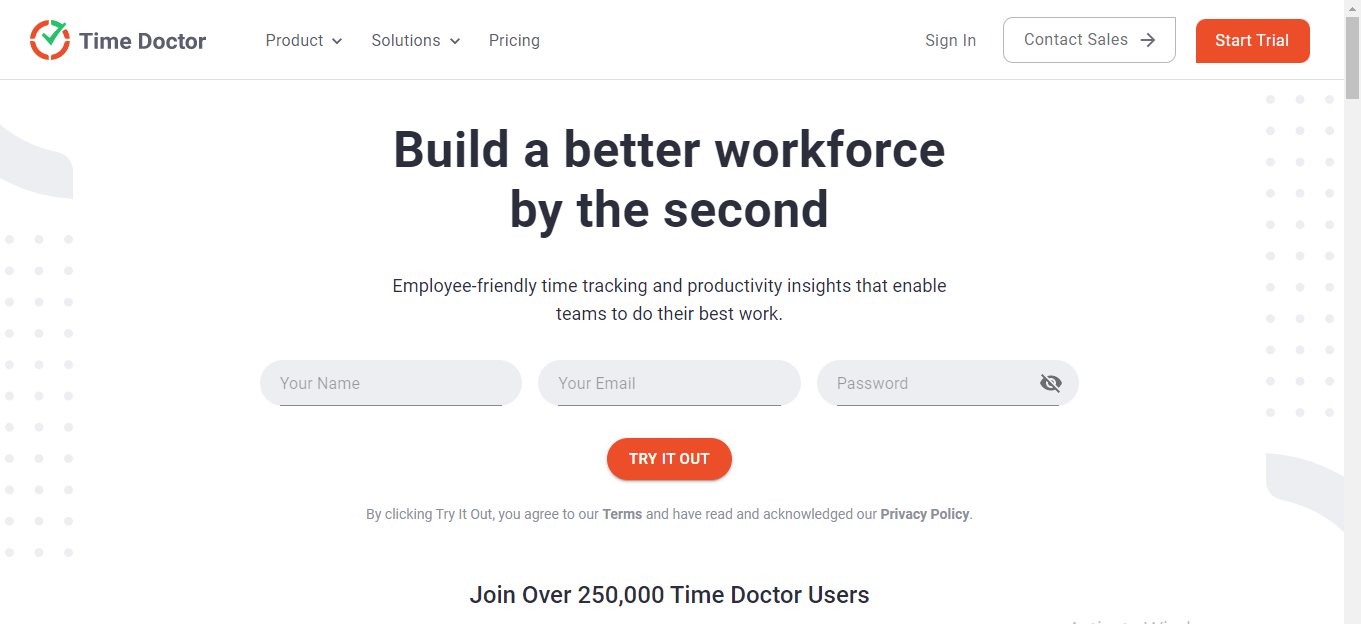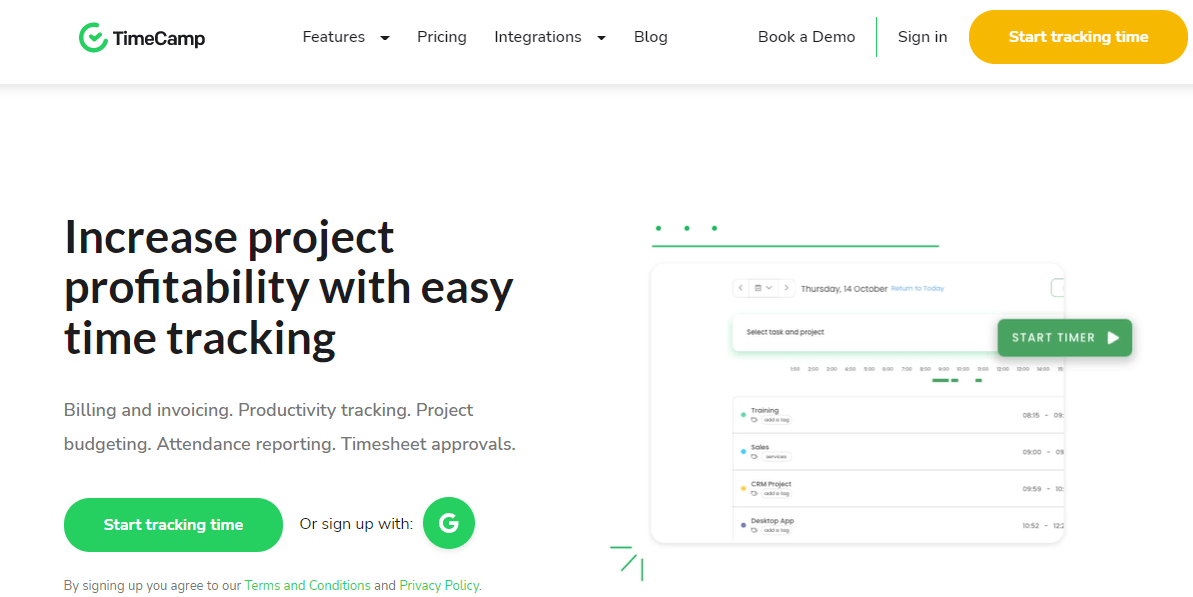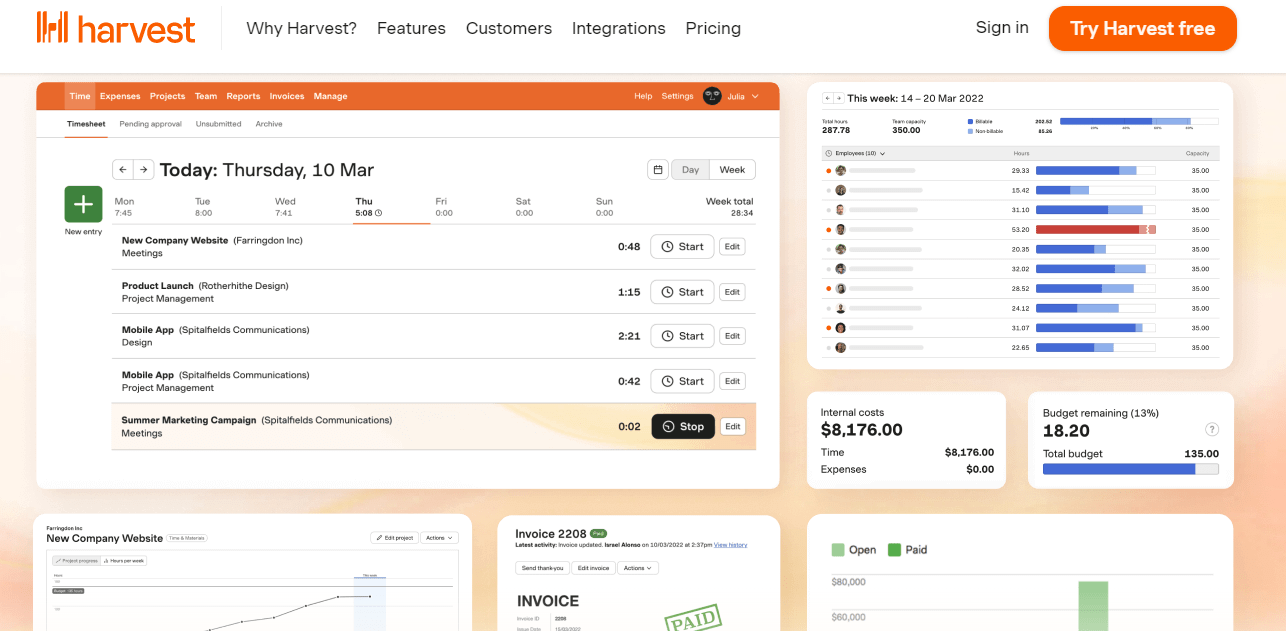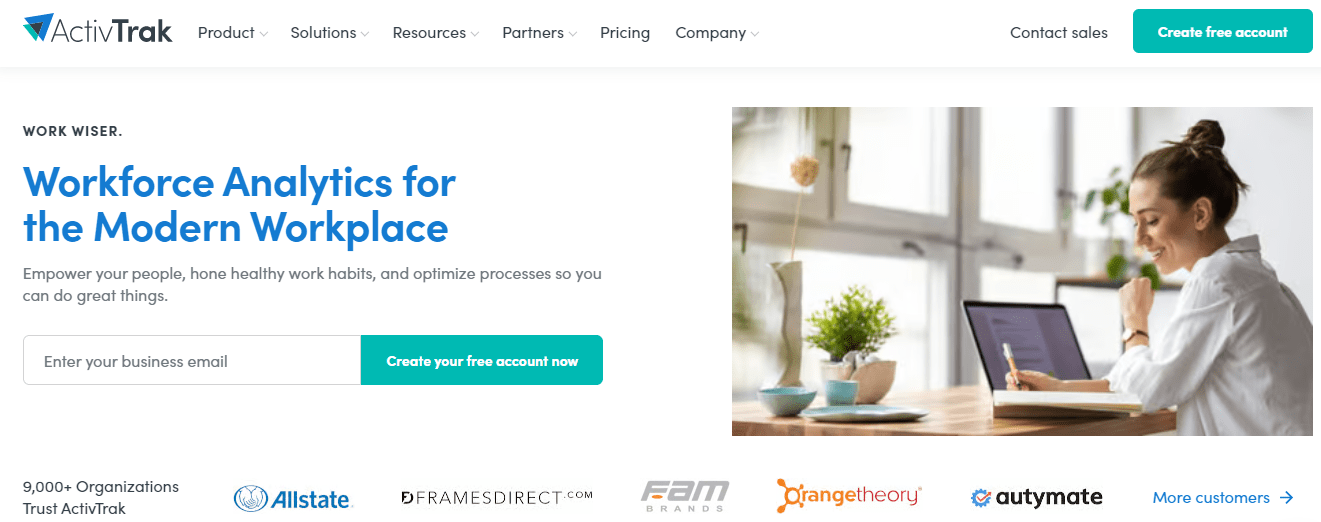Time tracking is an essential practice we should all get in the habit of. It’s even more important for you if you’re a solopreneur and don’t want to risk under or overcharging clients. Or if you work remotely and must keep diligent records of your day’s activities. It’s equally vital for managers monitoring their team’s performance. And even businesses looking to track non-billable hours.
In short, knowing how time’s being spent lets you manage, monitor, and bill it accurately. Most importantly, tracking your hours can help you improve or maintain personal productivity.
Time Doctor is one tool that is popular among users, but it's not perfect. So, let’s see what is time doctor and what this time tracker has that recommends it to its more than 250,000 users –and what causes others to look for alternatives:
Time Doctor

Time Doctor is well-known for allowing users to track and improve their teams’ efficiency. One of its key features is linking time tracking to employee performance insights. For instance, managers can easily keep up with which team member has the highest project success rates or smallest number of absences.
A deeper dive would show potential users say the following about the time doctor software:
Features
- Time logs maintained
- Makes employee capacity management simpler
- Billable hours tracking available
Cons
- Allows manual editing of time, which can create doubts about actual working times.
- Inaccurate break-time tracking and can get activated when a user’s mouse doesn’t move for a while–a flaw for users whose jobs require long spells of brainstorming and reading
- The activity bar is large enough to disrupt the working process.
- Monitors employee activity by taking screenshots.
Believe it or not, the last con is a deal-breaker for us! It’s also something that led to the birth of timegram. If you’re in the same time tracking boat, then you’ll soon see it as the best Time Doctor alternative among the many others we found for you:
TimeDoctor Alternatives to Try
1. Hubstaff

Patronized by more than 95,000 businesses, Hubstaff is offering a mixture of features useful in time tracking, agile project management, and employee monitoring. Single-user plans are free, while custom enterprise-level packages are also available.
Features
- Tracking modes include GPS, screenshots, and URL
- May be used in project management
- Invoice tracking also available
Cons
- Intrusive automatic screenshots
- Difficult-to-navigate interface
- Inundation with reports and data can be overwhelming
- Highly priced for small teams & solopreneurs
Not to be missed: 5 Hubstaff Alternatives To Make Your Team More Productive
2. actiTIME

actiTIME is all about project and team management. Therefore, its time tracking features are accurate to the nth degree. And, while it’s not as extensive as Hubstaff, actiTIME is perfect for SMEs and their on-site, remote, or hybrid teams.
Features
- Time tracking & reporting
- Manages billable hours
- Sends automated reminders & payments
Cons
- No report customization possible
- Integration with external planning tools is problematic
- Dashboard too cluttered for ease of use
3. timegram

timegram is a non-invasive time tracking and project management tool that prioritizes employee privacy while capturing performance insights.
It simplifies management and enhances the productivity of remotely-working and hybrid teams. Performance reporting is the third primary module, along with project management and time tracking.
timegram lets you optimize various trackable metrics, such as individual and team-based capacities and performance. Once set up, this tool will keep whirring in the background, allowing you to work without worrying about manually turning the timer on and off.
There’s one more factor that adds to the overall employee-friendliness of this app. It doesn’t capture user screenshots, log your keystrokes, or take webcam shots.
Finally, it's perfect for SMEs with a strength of 20 people or less.
Features
- Automates time tracking via auto-launching desktop app–called Highlights–on startup
- Enhances productivity with a clean and easy-to-use UI and brings transparency to performance evaluation
- Simplifies project, resource, and team management
- Puts user privacy ahead, which means no tracking via screenshots, webcams, keystrokes, or other employee surveillance tools
- Generates performance reports purely through outputs and inputs
- Tracks performance based on individual, team, task, and project-based activities
- Accurately track billable hours and automatically creates invoices based on time-spent
Cons
- The privacy-first stance isn’t to everyone’s taste and can even be a deal-breaker for some managers
- Ill-suited to agile team management due to lack of any feature dedicated to sprint management
- Limited in the software it will integrate with
4. Wrike

Since it doesn’t claim to be a pure time tracking tool, Wrike is equipped with a wider range of work and project management features than anything else. It’s also why you’ll spot various visual dashboards for a seamless workflow.
Features
- Automated workflow
- Easy project and resource planning–also allows the addition of external collaborators
- Custom dashboards and integrations
- It is excellent for complex project management, especially in the case of software teams
Cons
- Quite costly and thus, impractical for small teams
- Feature-studded layout can make onboarding and first-time use difficult
- Projects get buried after completion and are unavailable on the dashboard
5. TimeCamp

A timedoctor alternative that’s focused on both project management and time tracking. So, you can use it for collaboration, billing clients, and tracking non-billable hours. The desktop version of the app will track employee activity. The timeline view allows you to manage multiple projects simultaneously.
Features
- Time tracking is automated and allows room for approvals
- Leave management is possible through a separate window
- Uses time tracking data for invoice generation
Cons
- Non-customizable pricing plans
- Limited functionality and utility of the mobile version
- May allow multiple project management but gets a cluttered look due to multiple incoming entries
6. DeskTime

DeskTime is a desktop and mobile time tracking app for companies and freelancers. It makes measuring productivity, boosting performance, tracking attendance, and effectively managing workflow easy. Like any dood time doctor software, DeskTime boosts employee productivity by 30% within the first few weeks of use.
Features
- Automatic on- and offline time tracking
- Project management
- Scheduling of absences and shifts possible
- Screenshot surveillance optional
- Reports customizable
Cons
- Does not allow managers to track on-the-phone time for certain employees, such as the sales team
- Will automatically log out users, resulting in multiple reload sessions
- Takes screenshots after every few minutes, making employee privacy and working on confidential projects almost impossible
- Only starts new-day employee activity analysis after midnight, making it difficult for night shift workers to track time
- Reads any time away from device, such as for attending meetings, as employees being inactive–inaccurate time reporting
7. Insightful

If you require a timedoctor alternative software that’s all about workforce analytics and productivity, then Insightful may be a good choice. Its actionable data insights make informed decisions possible. So, you can use it to make processes more efficient, workflows better, and balance the load of team members.
Features
- Tracks project/task completion time
- Rate adjustment based on project, user, role, task, etc., possible for billing
Cons
- Timer icon fails to indicate it’s not recording productivity. Users complain about various such instances where shift time has gone unrecorded.
- Doesn’t differentiate or allow custom labeling of productive vs. unproductive tasks or indicate which hours were not spent productively.
- Would improve with a neutral/non-productive timeline view like its Active mode.
8. Harvest

Harvest is a good time tracking candidate because it integrates with project management tools like Slack and Asana. In addition, it presents various visual reports that help run projects smoothly and seamlessly.
Features
- Timesheets are easy to complete and transform into billable invoices
- Creates and delivers invoices to clients while also tracking electronic payments and revenue
- Mobile version is available
- Will send out automated timesheet completion reminders, differentiated on the basis of users, roles, or performance metrics
Cons
- Carries a too-heavy price tag for software that does nothing more than track time and measure project completion timing
- Doesn’t have functions for project management and accounting
9. Toggl Track

Toggl Track’s flexible nature ensures it can become a part of most workflows. It’s also easy to use and syncs across devices. Time tracking reports come out organized and ready for client viewing.
Features
- Will eliminate time-intensive clutter, including repetitive admin tasks, unprofitable projects, and uneven work distribution
- Does automatic tracking and timesheets are easy to complete
- Time to projects and tasks can be transformed into invoices for billable hour management
- Creates and delivers invoices for clients and tracks incoming revenue
Cons
- The timeline data has a week-long shelf life, after which it disappears from users’ view
- Demonstrates hampered connectivity when integrated with certain tracking tools. Users must manually move their hour data to and from Toggl in such cases.
- Doesn’t allow modification of the finish time and requires resetting the project’s length overall .
10. ActivTrak

ActivTrak advertises its usership is 550,000 strong, based on its digital workforce analytics, allowing them to optimize productivity and ensure employee wellness.
Features
- Surveils employees on various fronts, including web usage, log-ins, social media, and screenshots. In short, it creates reports based on user activity on each machine.
- Analyzes user behavior constantly.
Cons
- Can make employees feel micromanaged and as being under watch all the time.
- Annual subscription plans allow the addition of licenses, but no downsizing is possible for organizations that are scaling down.
11. Apploye

Apploye works for in-office, on-mobile, and remote teams. It’s one of the few timedoctor alternatives that claims to scale up or down to serve all types and sizes of entities.
Features
- It tracks time through screenshots and also monitors employee activity through timesheets.
- Presents an organized dashboard for an enhanced work management experience.
- Also tracks project time and billing for accountants.
Cons
- Task scheduling isn’t available on Apploye
- Neither is a way of managing attendance and leaves.
- The invasive nature of the screenshot tool has been a cause of friction between management and employee users.
What Happens When Employers Don’t Differentiate between Time Tracking & Employee Tracking?
In 2020, the demand for employee monitoring software doubled. Searches for ways of monitoring remote teams hit the roof as did for software that performs the task via:
- Desktop monitoring
- Video surveillance
- Keystroke tracking
- GPS tracking
Aside from some instances, such as when Microsoft came up with smartwatches for employee wellness data collection, most monitoring tools choose other areas to focus on, such as:
- Performance tracking
- Boosting productivity
- Deterring rule-breakers
Forrester is predicting the focus on employee monitoring to be at an all-time high for businesses this year. Based on such prevalence, you’d expect these tools to usher in a golden age of workplace behavior. Unfortunately, however, there were more cases of the measures backfiring than working out for the employers!
The M-Word
A study surveying 100 employees–a mixture of those monitored at work and those without– brings surprising results to the forefront.
Monitoring resulted in employees being more likely to:
- Indulge in unapproved breaks
- Take office equipment
- Disregard instructions
- Work slowly
- Damage office property
Another survey links this correlation to causation. It surveyed twice the number of employees. The participants being surveilled were more likely to cheat when informed of being under observation and allowed to cheat. And the only thing that deterred the cheaters? Fair treatment.
Lesson for Employers
If you care about preserving your employees’ sense of agency, it’s best to:
- Stay away from unilateral application of time tracking tools
- Have your team set boundaries and decide when surveilling them is off-limits
- Respect the said boundaries and maintain transparency about your monitoring practices
- Aggregate and anonymize surveillance data but make it accessible to employees
- Use data from surveillance to design informed wellness initiatives and create opportunities for professional development
Remember that close to 70% of your workforce might walk due to the forced implementation of audio/video-based surveillance systems. So, you’d best come up with non-invasive, privacy-first time tracking solutions!
Does such a Solution even Exist?
As obvious, most timedoctor alternatives aren’t built to foster employer-employee trust and can even ruin this delicate relationship. Someworkers would forgo this invasion of their privacy, while capable managers believe in instilling accountability within their teams. So, if you’re a responsible employer who cares about employee wellness, it’s best to go with the only option that ticks all ethical and functional boxes, i.e., timegram.
It focuses more on assisting individuals find their peak productivity time, is user-friendly and declutters your view to present only the most useful data and analytics via the Highlights app.
Thinking of trying out timegram? Welcome aboard!
FAQs
What are time tracking tools; explain?
If you don’t know what is time doctor or about other time trackers, it’s high time you did. These online tools record employee work hours so the management can accurately measure their working time. They also allow the latter to get insights into time distribution, based on tasks, projects, and clients.
Who uses time tracking software?
Everybody who wants to figure out how they’re spending their hours should use time tracking tools. However, they are crucial for workers who receive hourly wages, such as laborers, freelancers, etc. They’re also useful to businesses using cost-plus pricing. Managers of remotely working teams find project planning easier when they use a time tracker.
Can you monitor employees without their knowledge?
The question about employee surveillance shouldn’t be about its legal nature. Instead, employers should also consider the ethical side of this issue. After all, several applications built on invasive designs are available that will screenshot employee screens throughout the day. But do they really improve productivity? In many cases, they do the opposite, i.e., cause employees to find ways to cheat the surveillance system!
.svg)













.svg)
.webp)